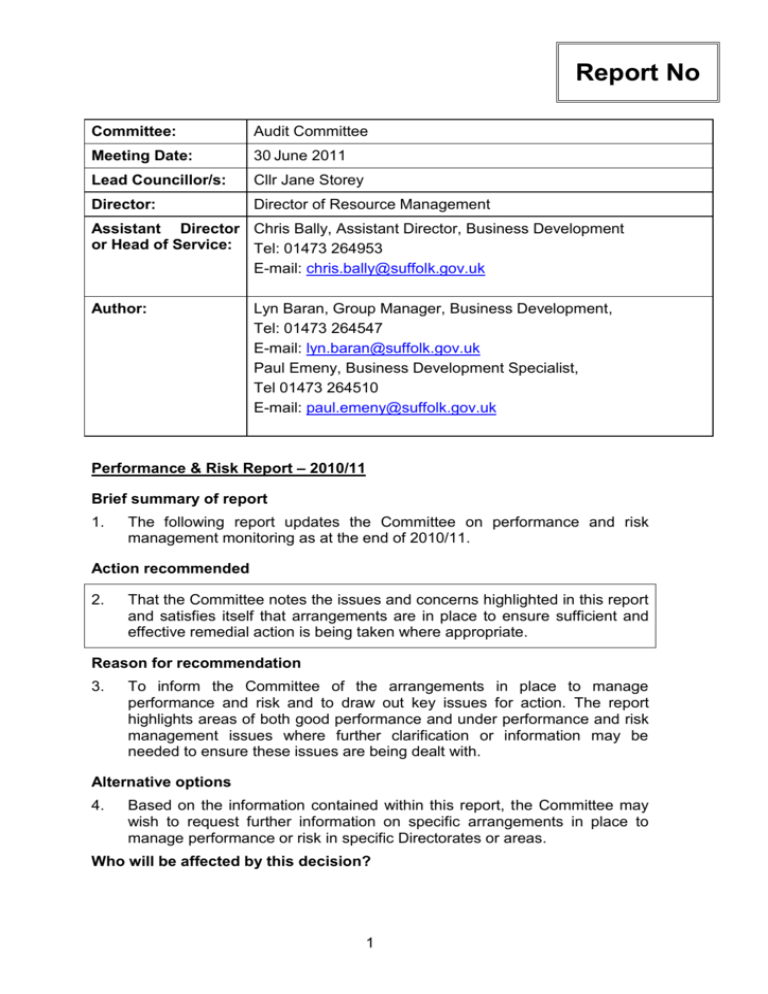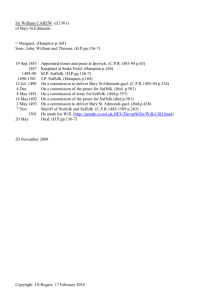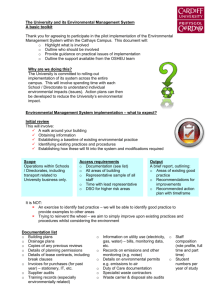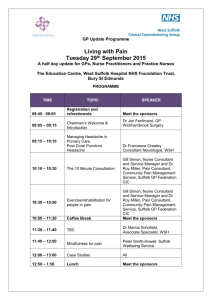Non Executive Template - Suffolk County Council
advertisement

Report No Committee: Audit Committee Meeting Date: 30 June 2011 Lead Councillor/s: Cllr Jane Storey Director: Director of Resource Management Assistant Director Chris Bally, Assistant Director, Business Development or Head of Service: Tel: 01473 264953 E-mail: chris.bally@suffolk.gov.uk Author: Lyn Baran, Group Manager, Business Development, Tel: 01473 264547 E-mail: lyn.baran@suffolk.gov.uk Paul Emeny, Business Development Specialist, Tel 01473 264510 E-mail: paul.emeny@suffolk.gov.uk Performance & Risk Report – 2010/11 Brief summary of report 1. The following report updates the Committee on performance and risk management monitoring as at the end of 2010/11. Action recommended 2. That the Committee notes the issues and concerns highlighted in this report and satisfies itself that arrangements are in place to ensure sufficient and effective remedial action is being taken where appropriate. Reason for recommendation 3. To inform the Committee of the arrangements in place to manage performance and risk and to draw out key issues for action. The report highlights areas of both good performance and under performance and risk management issues where further clarification or information may be needed to ensure these issues are being dealt with. Alternative options 4. Based on the information contained within this report, the Committee may wish to request further information on specific arrangements in place to manage performance or risk in specific Directorates or areas. Who will be affected by this decision? 1 5. Service users, councillors and officers responsible for specific service areas. Main body of report 6. The past year has seen significant changes to the performance management regime in local government. The new administration’s commitment to reducing the burden of reporting through the abolition of the national performance framework and indicator set and the publication of the Single Data List has yet to be tested in practical terms and this report looks back at arrangements in place for 2010/2011 and provides a commentary on performance and risk. 7. Performance against the corporate priorities has been varied. The fallout continues from the recession, with little positive news for strengthening the jobs market for example and education attainment whilst on an upward trajectory is still predicted to fall short of national standards. Positive improvements in supporting some of the most vulnerable in our county is recorded through doubling the numbers of adults with learning disabilities in paid employment, but this still represents just 7% of the known client group. The cost of purchased placements continues to rise as more children are taken into care or require child protection plans. There is good news on Suffolk’s greenest county aspirations with continued success with waste management and there are also signs that we are changing services to meet customer needs with an increase in self-directed support. 8. Work on risk management across the council has been progressed in the last 6 months, supported by business development staff. With the many changes in structures and staff the focus of work in the next 6 months is to ensure all risks logged on the corporate risk register have an appropriate owner and that 100% of reviews take place on time. Early improvements are in evidence as the ease of use of the new web-based system for risk management is demonstrated to operational colleagues. 9. A detailed performance and risk summary is provided at Appendix 1. 10. The Annual Governance Statement records the Council’s approach to performance and risk management as adequate. This approach includes regular operational performance and risk reporting to Directorate Management Teams and exception reporting to the Corporate Management Board. Outcomes from Inspections are reported to both officers and Members and there is an annual report which is presented to Portfolio Holders and Corporate Management Board. The Audit Committee receives this Annual Performance and Risk report and assurance through the Annual Governance Statement. 11. As reported in the Annual Governance Statement, 2011/2012 will largely be a transitional year and work is underway with directorates to establish new performance frameworks that are relevant to the Council’s business going forward and meet emerging statutory requirements including the new ‘Single Data List’ for Local Government. Sources of Further Information Performance against Corporate Priorities; 2 http://views.suffolkcc.gov.uk:8080/library.html Detailed Corporate Risk Report; http://colin.suffolkcc.gov.uk/SpecialistSupport/PPI/RiskReports 3 Performance & Risk Summary 2010/11 - Appendix 1 Performance: introduction The following report summarises issues and concerns arising from performance monitoring during 2010/11. At this stage, we are still monitoring the final outturns for the National Indicator Set 2010/2011. We are also looking ahead to review the measures that the Council wants to use to manage its business going forward. This work is ongoing but it is intended that by the outturn of quarter 1 2011/12 (end July 2011) the most appropriate measures to determine how the organisation is performing against its priorities will be produced and monitored on a quarterly basis. This will include reporting on finance and human resources from the new Business Intelligence tool. This report also includes a strategic risk management update/summary and a summary of the current list of overdue risks at Appendix 2. Performance Overview This section includes a summary of performance against the corporate priorities, as identified in the Suffolk Story and an indication of current trends based on the most recent information available. Each measure (for each of the corporate priorities) is colour coded to indicate the latest performance trend and direction of travel (a key to explain specifically what the colour coding means is provided). A detailed breakdown of the performance measures used can be viewed online using Colin. A link on Colin directs you to ‘SCIViews’ – the council’s performance management system. SCIViews is themed by corporate priority and includes commentary to add further context to the data where performance has changed significantly. Link: http://views.suffolkcc.gov.uk:8080/library.html Key for understanding latest performance trends. Excellent Caution Good Poor V Poor No update For the purposes of this report a summary showing the latest trends is provided which shows the current progress against each of the corporate priorities. The colour coding used in the summary below corresponds to that used in SCIViews. Key - Direction of travel; Direction of Travel Change since last quarter Improved Declined No change 4 The direction of travel arrows show whether performance has got better or worse since the last quarter’s report. Performance against Corporate Priorities A Strong & Dynamic Jobs Market There are eight measures currently used to determine how well the council is performing against this corporate priority. Four are currently judged as being ‘grey’. This is because they are national indicators which are not reported until 9 months after the end of 2010/11 and as a consequence the council is waiting for new information to be published. Employment rate Out of work benefit (target wards) ESE Employee earnings Out of work benefit claimants s Affordable Homes s Small business growth s Skills gap in workforce s Employment in key sectors s Affordable Homes This key housing target which was also an LAA2 target is unlikely to be achieved based on the latest trend information available (however this is still to be verified). All Districts Councils in Suffolk reported a decrease in the annual completion rate of affordable homes compared to the previous year. Suffolk Coastal District Council only saw 368 homes completed - the lowest number of homes since 2001/02, whilst Ipswich Borough only saw 545 completions - the lowest since 2002/03. Transforming Learning and Skills in Suffolk Under the Transforming Learning and Skills theme one of the main focuses is on school children and adult learning attainment – as well as other key schools related measures which collectively give a good sense of how the council is meeting this very important priority. In this section, as well as the measure/colour summary there is also some more detailed analysis providing an overview of how the council is performing at both Key Stages 2 and 4 when compared to its statistical neighbours and England averages. Visits to libraries Young offenders engaged ESE Level 2 qualification by the age of 19 Visits to museums s Early Years Foundation Stages Level 3 qualification by the age of 19 Schools less than 55% KS2 maths/eng KS2 Maths and English Schools judged as good standards Schools less than 30% 5 GCSE A-C 5 or more A*- C grades at GCSE Persistent school absence Schools with extended services Schools in Special Measures Take up of 14-19 learning diplomas Participation in education & training LAC achieving KS2 English LAC achieving KS2 Maths LAC achieving 5 GCSEs SEN excluding exceptions SEN achieving KS2 Maths & English Delivery of Sure Start SEN including exceptions SEN achieving 5 GCSE A - C Permanent exclusions 16-18 year olds (NEET) Care leavers education/employment Adult learning – Level 1 Adult learning – Level 2 Adult learning – Level 3 % access extended schools Focus on Transforming Learning and Skills Attainment at Key Stage 2 5 Annual progression at KS2 L4+ for both English & Maths Spring Term Assessment 78 76 74 72 70 Suffolk 68 England 66 Stat. Neighbours 64 62 cte d pr ed i 20 10 20 11 20 09 20 08 20 07 20 06 20 05 60 School improvement partners reported on schools progress for the spring term. For middle and primary schools the attainment scores predicted for the percentage of pupils achieving Level 4 or above at KS2 (for both English and Maths) would translate to an approximate score for the county of 76%. However, in the previous year a predicted score of 73% resulted in an actual score of 68%, so caution needs to be taken as a potential margin of error will need to be taken into consideration. However, if this predicted score was realised this would represent an improvement of 3% on the previous year potentially bringing Suffolk in line with statistically similar counties. Attainment at Key Stage 4 NI 75 5+ GCSC A* - C Grades including English & Maths 58% 56% Suffolk Stat. Neighbours 54% England 52% 50% 48% 46% 44% 42% 40% 2006/07 2007/08 2008/09 2009/10 2010/11 predicted For KS4 the overall predicted scores would translate to a score of 56.7%, representing an improvement on the previous year moving Suffolk just ahead of the current national average of 55.2%, but again caution needs to be taken. The predicted difference in achievement between 2 and 3 tier schools shows the average in the 2 tier system as being 59.7% and 53.6% in the 3 tier. Protect Vulnerable People and Reduce Inequalities 6 The measures for this priority/theme cover a diverse range of service areas – including road and fire safety, looking after vulnerable children, and timeliness of adult social care and adoption placements. As well as the measure/colour summary below there is also commentary to provide context on the measures judged as ‘red’ as well as some further analysis intended to give an overview of how the council is performing against key children in need measures when compared to its statistical neighbours and England averages. People killed/seriously injured roads Child & adolescent mental health servicesESE Stability of LAC placements (time) Children killed/seriously injured roads Initial assessments in timescale (child) Child Protection Plans (over 2 yrs) Number of Looked After Children Core assessments in timescale (child) Child Protection Plans (second time) Number of purchased placements Timeliness of adoption placements Child Protection reviews in timescale Repeat incidents of domestic violence Stability of LAC placements (number) LAC cases reviewed within timescale % referrals going to initial assessment Long term conditions supported Initial assessments in timescale (adult) Vulnerable people – independent living - independence Independence for older people Timeliness of care packages (adult) People Learning Disability - settled Care leavers suitable accomodation Serious crime in pubic place People Learning Disability – jobs Older people feeling safe Primary Fires Fatalities - Fire Obesity in primary school children Mortality rate (health) Casualities - Fire Teenage conception rate Self directed support Adults with Learning Disabilities in Settled Accommodation 1,642 adults with learning disabilities of working age (18 to 64) are currently known to Adult Social Care. Of the 599 who were reviewed, 36% were in a form of accommodation that was deemed to be settled for them. This compares to 49% in 2010 when there were 790 reviews completed from a total of 1,592 people. This apparent fall in numbers is not a reflection of the current housing situation but rather of the reduction in the number of reviews completed in the financial year. If a review were to be undertaken for all customers with Learning Disabilities, then it is highly likely that performance would improve. Adults with Learning Disabilities in Employment in comparison to last year the number of working age adults with a learning disability who are being supported in to paid employment has risen quite considerably. In 2010, there were 71 individuals known to Adult Social Care in paid employment, from the same total of 1,592 customers (or 4.4%). This figure has since risen to 115 from 1,642 (or 7%). This is due to work undertaken by Whitehouse Enterprises with Learning Disabled clients within the past year. Looked After Children the number of Looked After Children is currently 795 with overall numbers increasing since April. The reliance on externally purchased care has a current projected cost of £10.8 million. Number of Looked After Children - 2007 to date 810 790 770 750 730 7 Children in Need – Child Protection Plans. The current number of children with a Child Protection Plan has increased to over 600 as at April 2011. Number of Child Protection Plans 600 550 500 450 400 ar /M /J a n 20 11 ov 20 11 p /N 20 10 l /S e /J u 20 10 ay /M 20 10 ar 20 10 n /M /J a 20 10 ov /N 20 10 p 20 09 l /S e /J u 20 09 ay /M 20 09 ar /M 20 09 /J a n 20 09 /N 20 09 20 08 20 08 /S e p ov 350 Be the Greenest County These measures focus primarily on waste management and progress against the council’s emissions targets. Residual household waste collected per head of population results for this year were 126.6 kilograms compared to 129.1 kilograms last year, a slight decrease which is encouraging news. The percentage of household waste recycled or composted this year was 50.7% compared to 47.2% last year, a significant increase, which again is very good news. The county’s CO2 emissions target (which is also an LAA2 target) is unlikely to be achieved based on the latest trend. However, because this data is reported nationally and takes 2 to 3 years to be published, the county will not know the actual outcome for the LAA2 target for some time, but the indication is not encouraging. Local bus passenger journeys % waste recycled & composted Residual household waste (tonnage) Reduction in CO2 emissions % waste landfilled School Travel 8 Deliver Great Services at Exceptional Value The provision of self-directed support and supporting people to live independently are areas where the council has performed well this year. In terms of measuring ongoing net cash savings and value for money, this is an area where nationally available information is now limited and therefore the council may wish to identify new measures to gauge its direction of travel for providing value for money to feature in future reports. Clients receiving self-directed support Business satisfaction with regulation People supported to live independently Delayed transfers of care Adult participation in sport & recreation net value of ongoing cash release vfm Principal roads requiring maintenance There has been an increase in the number of delayed transfers of care this year; however it is not as great as it may appear from the figures at hand. This is due to a delay in the release of updated population estimates from the ONS. Mid 2010 estimates won’t be released until August, and so the weekly patient outturn for Delayed Transfers of Care for the year to date is artificially high. Performance Information – Statutory Returns Currently, statutory returns remain in place and are a considerable burden on the council across various teams and directorates. The Government’s new single data list maintains most of the statutory reporting mechanisms that were in place in previous years, including Adult Social Care returns such as RAP (which has been expanded since 2009-10), ASC-CAR, the PSSEX1, and Children’s Social Care returns such as the SSDA903 for Looked after Children and the Child In Need (CIN) Census. Any return listed on the Single Data List is mandatory but we are working to streamline activity required to prepare the submissions by focusing on improving data quality at source and so reduce the need for data cleansing at year end. Adopting this approach to date has meant that the council has significantly reduced the need for additional temporary staff to complete the submissions work. 9 Risk Management Overview Suffolk County Council promotes risk management through ensuring that all directorates and service areas within Suffolk County council (SCC) embedding the process of risk management within the day-to-day operational activities of SCC. Business Development’s role is to provide an oversight function - the second line of defence in the Corporate Governance Model. It ensures that operational managers are fulfilling their risk management obligations and so to provide assurance to the organisation. Business Development also promotes the benefits to be derived from risk management, both from departmental and corporate perspectives. THE THREE LINES OF DEFENCE FOR GOOD GOVERNANCE The First Line of Defence is operational managers and staff (the organisational operations). The Second line of Defence The Third line of Defence is the oversight functions are Internal Audit and External (e.g. Business Development, Assurance Providers. Finance; HR; ICT). They offer independent They have day-to-day responsibility for managing and controlling risk. They set directions, define challenge to the levels policy and provide of assurance provided by assurance. business operations and oversight functions. AUDIT COMMITTEE In order to deliver this function, Business Development (BD) has identified individuals to take responsibility for promoting risk management at a strategic level, to act as a risk management advocate, offering support and challenge to operational teams , and risk management system administration to enable risk actions to be tracked and monitored. In the last 6 months since this model has been adopted, we have used the JCAD tool to identify risk management activity and ‘cold spots’ by auditing use of the site and chasing overdue reviews of risks. Meetings with key service areas have begun to encourage more proactive use of the site and to check that appropriate action is being taken. 10 Given the many changes happening in service areas, this action is timely, though incomplete at this stage. An overview is provided in the table below which identifies common issues which have been identified and are being addressed, and an assessment of the state of risk management in each area contacted to date. Issue Use of JCAD is low as it is perceived to be unnecessarily laborious and not user friendly Description The previous version of JCAD was based on a ‘one size fits all’ approach’ that required users to go through all stages of RM even when it was not necessary to do so. For example, when the risk assessment has already been done outside of JCAD. Performance issues and lack of ease of navigation contributed largely to making JCAD user unfriendly. Misconception that formalisation of RM framework is nonvalue adding exercise. Formal risk management recording seen as something that is done after a risk has been managed rather than part of an active and ongoing process. This led to risk management being seen as a meaningless, nonvalue adding exercise that detracts from doing the ‘real’ valueadding work. 11 Action taken The JCAD system has been upgraded and the current version is web-based and vastly improved in terms of ease of use. It is more flexible and logical in the implementation of the RM process. The performance of the system in terms of speed is also noticeable. Colleagues are more receptive to the tool once they have interacted with it. JCAD is now seen as a tool that could add value to their work, through the proper implementation of RM, rather than a bureaucratic tool used for the purpose of satisfying audit requirements. Business Development is raising awareness of the improved JCAD system among colleagues and encouraging them to use the tool, where they haven’t and effective RM system in place already. A simpler approach to risk management focused on ensuring that the organisation considers ‘the likelihood of something going wrong’ and ‘the impact of something going wrong’ in its planning has been accompanied by work to reenforcing the importance and benefits of active risk management. The need to ensure corporate visibility to support high-level decision making is also being promoted. In addition to this, Business Development is making colleagues aware of the importance of tailoring RM approach to be proportionate, to Issue Description Directorate / Service Area risk ownership Restructures in directorates and service areas has resulted in uncertainty, particularly with roles, making it difficult to assign / reassign ownership to risks. Some directorates / service areas, although practising RM in silos, do not have a co-ordinated approach to RM that will deliver efficiency in their approach. Lack of integrated approach to RM Action taken suit the corporate environment and to be an integral part of normal day-to-day activities. The emphasis is on helping colleagues to make the shift from ‘bureaucratic’ RM to ‘real’ RM, through the realisation of the benefits to be realised. The responsibility for leadership in risk management is shared across the Business Development team. The situation is improving as the various restructures are being completed. Business Development is reviewing risk owners and working with directorates to transfer risk to new owners and offer training and support where needed. Promoting knowledge sharing and ‘best practice’: Making colleagues aware of the benefits associated with an integrated approach. Encouraging colleagues to learn from other directorates where the integrated approach is working well. Using reports generated by the JCAD system we are chasing overdue reviews and there are encouraging signs of progress in this area. The current JCAD report of overdue risks, as of 31st May 2011, is presented as a table below. The data shows a downward trend in the number of overdue risks, compared to the same report produced on 2nd February 2011. As of the time of writing, risk owners are taking steps to address outstanding actions that should further drive down the number of overdue risks in subsequent reports. Also, we are working with directorates and service areas to ensure that all assigned risk / control owners are valid and current employees of SCC. Overdue Risk level Very High High Medium 2nd February 2011 18 58 94 31st May 2011 13 50 88 The goal is to report zero overdue risks. An assessment of the current situation regarding risk management practice is provided in the table below: 12 Directorate / Service Area ACS CYP Status 15/4/11: Initial review meeting held. Follow-up meeting to be scheduled for August 15/4/11: Initial review meeting held. Follow-up meeting to be scheduled for July Public Protection, Social Inclusion and Diversity Initial meeting to be scheduled. ESE 13/4/11: Initial review meeting held. Follow-up meeting to be scheduled for July Monitored by CMB meetings Corporate Management Board Resource Management Initial Review meeting to be scheduled for July with RM Team Corporate Health and Safety 20/4/11: Initial review meeting held. Follow-up meeting to be scheduled for July Risk management – Commentary A structured and integrated approach to RM is in place. Inconsistent use of JCAD addressed and follow-up meeting to review use of JCAD. Coordinated approach to risk management across Directorate has been adversely affected by long-term staff absence. Uncertainty due to the Directorate restructure has hampered attempts to making RM more effective. Actions are being driven by reports on JCAD across the Directorate. Risk management arrangements adequate. Inconsistent application of risk recording. Actions are being driven by reports on JCAD. Discussions regarding effective working of RM within the group held on 24 March 2011. Responsible for risk management leadership across organisation and focused work on corporate health and safety. Inconsistent use of JCAD but risk management and recording arrangements in place. Move to better use of JCAD. Health and safety risk management has improved considerably. Inconsistent use JCAD due to poor user experience of earlier versions of the tool. Following intervention, JCAD to be used to log top 10 corporate H&S risks. The new approach is beginning to have an impact on recognition of active risk management process and recording of risks and mitigating actions. There is more to be done in ensuring that as directorates emerge from restructuring and as services are considered for alternative delivery methods, that appropriate 13 consideration and management of risk is embedded in our approach. For the approach to be further improved and sustainable, it is important that; 1. periodic progress reviews with the directorates / service areas are scheduled and where arrangements are inadequate, raise the issues with management teams 2. ‘best practice’ and support learning / knowledge is share; and 3. the senior management team promotes risk management and leads by example. Suffolk CC Very High Risks overdue for review on JCAD: Currently there are 321 risks recorded on the council’s Risk Register (JCAD) divided between the directorates and their business areas. Of these there are 28 risks rated as very high (VH) - 6 are recorded as overdue for review and are listed below. This does not mean that they are not being actively management – indeed, it is clear from looking at all ‘topics’ that significant mitigation strategies are in place to minimise risk, but these strategies are not being recorded on the corporate system and therefore it is difficult for Directors and Members to access current information about these strategies without approaching service managers. Reference Nature CORP0053 Threat CORP0057 Threat CORP0054 Threat CORP0049 Threat CORP0055 Threat CORP0039 Threat Topic Current assessment Reduced central government expenditure Failure in health & safety management Conflict with partners and stakeholders over budgets CSD contract becoming unaffordable Failure to improve educational attainment in KS2 and KS4 20 Loss of data centre in Constantine House 10 14 20 16 16 12 Change Review status since Q3 report Very high Overdue since 02/02/11 Very high Overdue since 10/09/10 Very high Overdue since 17/06/10 Very high Overdue since 27/01/11 High Overdue since 15/03/10 High - Overdue since 05/04/11








